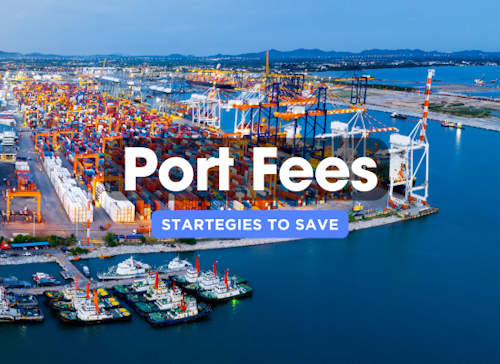Insider Strategies for Reducing Global Port Fees

In the highly competitive world of maritime shipping, every dollar counts. For ship and fleet owners, port fees are a significant part of operating costs, but they don't have to be a fixed expense. By understanding the nuances of port fee structures, leveraging volume discounts, and strategically selecting ports, you can significantly reduce your overall costs. This guide offers in-depth insights and practical strategies to help you negotiate better deals and choose the most cost-effective ports, ensuring that your operations remain as efficient and profitable as possible.
| ShipUniverse: Global Port Expense Summary | |||
|---|---|---|---|
| Location/Region | Average Port Fees (Relative) | Key Factors Influencing Costs | Additional Considerations |
| France (Western Europe) | High | High labor costs, advanced infrastructure, strict environmental regulations. | Efficiency is high, but fees reflect the premium nature of services and location. |
| Pakistan (South Asia) | Low | Lower labor costs, developing infrastructure, fewer regulatory requirements. | Cost-effective but may face delays due to less developed facilities. |
| Singapore (Southeast Asia) | Moderate to High | Advanced infrastructure, high demand, strategic location on major trade routes. | Considered one of the most efficient ports globally, justifying the higher fees. |
| United States (East Coast) | High | High labor costs, modern infrastructure, complex regulatory environment. | Ports like New York and Charleston are major hubs, contributing to higher fees. |
| China (Eastern Seaboard) | Moderate | Massive throughput, government subsidies, advanced technology implementation. | Ports like Shanghai are highly efficient, with fees reflecting their central role in global trade. |
| Brazil (South America) | Moderate | Varied infrastructure quality, higher labor costs in urban ports, regulatory challenges. | Ports like Santos are critical for exports but can be costly due to bureaucracy. |
| United Arab Emirates (Middle East) | High | Advanced infrastructure, strategic location, government investment. | Ports like Jebel Ali offer state-of-the-art facilities but at a premium price. |
| Australia (Oceania) | High | High labor costs, stringent environmental regulations, remote location. | Ports like Sydney and Melbourne are modern but come with significant costs. |
| South Africa (Sub-Saharan Africa) | Moderate | Developing infrastructure, moderate labor costs, strategic location for regional trade. | Ports like Durban are essential for trade in the region but can be affected by inefficiencies. |
| Russia (Eastern Europe) | Low to Moderate | Lower labor costs, variable infrastructure quality, government-controlled fees. | Ports like St. Petersburg offer competitive rates but may lack modern facilities. |
| Japan (East Asia) | High | Advanced technology, high labor costs, strict regulations. | Ports like Yokohama are efficient and technologically advanced but expensive. |
| India (South Asia) | Low to Moderate | Lower labor costs, developing infrastructure, increasing government investment. | Ports like Mumbai are growing in importance but still face infrastructure challenges. |
| Germany (Western Europe) | High | Advanced infrastructure, high demand, strict environmental and safety regulations. | Ports like Hamburg are critical for European trade but come with high fees. |
| Turkey (Eurasia) | Moderate | Strategic location, improving infrastructure, moderate labor costs. | Ports like Istanbul are well-positioned for regional trade, offering reasonable fees. |
| Mexico (North America) | Moderate | Variable infrastructure, moderate labor costs, proximity to the US market. | Ports like Veracruz are key for trade with the US, offering competitive rates. |
| Vietnam (Southeast Asia) | Low to Moderate | Developing infrastructure, low labor costs, growing role in global trade. | Ports like Ho Chi Minh City are increasingly important but still offer competitive fees. |
| Egypt (North Africa) | Moderate | Strategic location on the Suez Canal, moderate infrastructure, government-controlled fees. | Ports like Alexandria are crucial for canal traffic but can face congestion. |
| Netherlands (Western Europe) | High | Advanced infrastructure, high demand, strategic location for European trade. | Ports like Rotterdam are among the busiest in the world, reflected in their fees. |
| Indonesia (Southeast Asia) | Low to Moderate | Developing infrastructure, low labor costs, strategic location for regional trade. | Ports like Jakarta are improving but still offer relatively low fees. |
| South Korea (East Asia) | High | Advanced infrastructure, high labor costs, significant government investment. | Ports like Busan are highly efficient but come with premium costs. |
Reducing Port Fees
Port fees can significantly impact operating costs, but strategic approaches can help reduce these expenses. This table outlines practical strategies for minimizing port fees, offering ship and fleet owners actionable insights to optimize their spending and improve overall profitability.
| ShipUniverse: Strategies for Reducing Port Fees | |||
|---|---|---|---|
| Strategy | Description | Implementation Considerations | Potential Savings |
| Long-Term Contracts | Negotiating multi-year contracts with ports to lock in lower rates and avoid annual fee increases. | Requires a strong relationship with port authorities. May involve a commitment to a minimum number of calls or tonnage. | 5-15% reduction in port fees, depending on the length and terms of the contract. |
| Volume Discounts | Securing discounts by committing to a higher volume of calls or cargo throughput at a specific port. | Best for larger fleets or frequent users of a particular port. Volume thresholds and discount rates vary by port. | 5-20% reduction in fees for high-volume users, depending on the port's discount structure. |
| Seasonal Rate Negotiations | Taking advantage of lower rates during off-peak seasons when ports have less traffic. | Requires flexible scheduling and the ability to adjust shipping routes and schedules to align with off-peak periods. | 5-10% savings during off-peak seasons, with potential for greater discounts during low-demand periods. |
| Bundled Services | Negotiating bundled service packages, such as docking, pilotage, and cargo handling, for a reduced overall fee. | Works best when a port offers a range of services. Requires a comprehensive understanding of service needs. | 5-15% savings on total service costs, depending on the extent of services bundled. |
| Port Selection | Choosing ports with lower fee structures or those that offer better terms for specific services. | Involves comparing multiple ports based on fee structures, service quality, and strategic location. May require a shift in traditional routes. | Varies widely, but choosing the right port can result in significant savings, especially over multiple voyages. |
| Early Payment Discounts | Negotiating discounts for early payment of port fees, often offered as an incentive by some ports. | Requires strong cash flow management to take advantage of early payment options. | 1-5% reduction in port fees, depending on the port's policies on early payments. |
| Using Port Agents | Employing local port agents who have in-depth knowledge of port fee structures and can negotiate better rates. | Choose experienced agents with a track record of successful negotiations. Agents typically work on a commission basis. | Potential for 5-10% savings through skilled negotiation and local expertise. |
| Using Digital Platforms for Port Services | Utilizing digital platforms that offer competitive rates for port services through transparent pricing and instant comparisons. | Requires familiarity with digital tools and platforms. May involve initial setup costs but provides ongoing savings. | Up to 10% savings by choosing the most cost-effective services available. |
| Revising Port Call Procedures | Optimizing the sequence of operations during port calls to minimize delays and avoid additional charges. | Involves detailed planning and coordination with port authorities and service providers. May require process adjustments. | 3-8% savings by reducing time-related fees and avoiding extra charges. |
| Utilizing Ports with Transparent Fee Structures | Selecting ports that offer clear, transparent fee structures to avoid hidden costs and unexpected surcharges. | Requires research and comparison of port fee schedules. Transparency helps in accurate cost forecasting. | Varies, but transparency can lead to more predictable and manageable costs. |
Port Fee Reduction Insider Tips
Leverage Local Knowledge for Last-Minute Deals
Many ports offer last-minute discounts or special rates for available berthing slots. By maintaining close relationships with local port agents or terminal operators, you can stay informed about these opportunities. For example, if a berth is unexpectedly vacant due to a cancellation, you might secure it at a reduced rate by being in the right place at the right time.
Optimize Cargo Operations to Avoid Overtime Charges
Ports often charge premium rates for services rendered outside normal operating hours. By carefully planning your cargo loading and unloading schedules, you can avoid costly overtime fees. Coordinate with local stevedores and port officials to ensure that operations are completed within standard working hours, and consider splitting operations over multiple days if it avoids after-hours charges.
Take Advantage of Port Alliances and Cooperative Agreements
Some ports have cooperative agreements with neighboring ports, allowing for shared resources or reduced fees if you're willing to use multiple ports within the same region. These alliances can offer reduced tariffs or bundled services. For instance, if Port A and Port B are part of an alliance, you might get a discount at Port B after using Port A, making it beneficial to split your cargo operations between the two.
Negotiate for Waivers on Environmental Fees
Ports are increasingly implementing environmental surcharges, especially for vessels that don't meet certain emission standards. However, if your ship has invested in green technologies or uses alternative fuels like LNG, you may be eligible for waivers or reductions in these fees. Don’t assume these discounts are automatically applied—proactively engage with port authorities to ensure your vessel’s green credentials are recognized.
Explore Flexible Berthing Options to Secure Lower Rates
Some ports offer flexible berthing options where you can request a berth in less congested areas of the port for a lower fee. This may require adjusting your operational schedule or being flexible with your arrival times, but the savings can be substantial. Ports may offer lower rates for berths farther from main cargo terminals or those with less demand.
Utilize Port Authority Rebates for Frequent Users
Certain ports offer rebate programs for frequent users that aren't widely advertised. These programs might provide rebates on fees after a certain number of port calls or tons of cargo handled within a specified period. Work with your port agent to track your usage and ensure you apply for these rebates. This can result in significant savings, particularly for fleets with regular routes.
Capitalize on Pilotage Exemptions Where Applicable
In some ports, experienced captains with local knowledge can apply for pilotage exemptions, allowing them to navigate their vessels without the assistance of a port pilot. If your captain qualifies, this can eliminate the cost of pilotage services altogether. However, securing these exemptions often requires meeting stringent criteria and undergoing assessment by port authorities, so it’s worth investigating well in advance.
Time Your Bunkering Operations with Port Calls
Some ports offer discounts on port fees if bunkering (fueling) operations are carried out simultaneously with cargo operations, as it reduces the overall port stay time. Coordinate your bunkering schedule to coincide with port calls, and negotiate with port authorities for a reduction in fees as a reward for efficient turnaround.
Negotiate Bulk Rate Adjustments for Multiple Ship Calls
If your fleet operates multiple ships calling at the same port within a short period, negotiate a bulk rate adjustment. Ports might be willing to offer a discount on total fees if you can guarantee a certain number of ship calls within a set timeframe. This can be especially useful during contract negotiations for a shipping season or on specific routes.
Monitor Real-Time Port Congestion to Avoid Delay Fees
Some ports are equipped with real-time congestion monitoring systems that provide data on berth availability and traffic flow. By staying informed about real-time conditions, you can adjust your arrival times to avoid congestion-related delays and the associated costs. Using this data, you can also negotiate better berthing windows or reroute to less congested nearby ports as needed.
Environmental Fee Waivers
As environmental regulations become more stringent, many ports have introduced fees and surcharges aimed at reducing the environmental impact of maritime operations. However, ship and fleet owners can often reduce or eliminate these fees by meeting specific criteria, such as using cleaner fuels, adopting green technologies, or implementing waste management programs. Understanding the requirements for these waivers and the associated documentation is crucial for maximizing potential savings. The table below outlines common environmental fee types, the typical criteria for securing a waiver or reduction, and the potential savings shipowners can achieve.
| ShipUniverse: Criteria for Environmental Fee Waivers | ||||
|---|---|---|---|---|
| Environmental Fee Type | Common Criteria for Waiver/Reduction | Required Documentation | Typical Savings (%) | Additional Notes |
| Emission Surcharge | Use of low sulfur fuel, LNG, hybrid propulsion systems, or certified scrubbers. | Fuel receipts, certification of fuel type, emissions testing reports, or scrubber certification. | 10-20% | Ensure compliance with IMO regulations to qualify; some ports may require advance notice. |
| Carbon Tax | Green certification from recognized bodies (e.g., Green Award), energy efficiency measures, or use of alternative fuels. | Certification from a recognized environmental body, energy audit reports, proof of alternative fuel usage. | 5-15% | Certification processes can be time-consuming; early application is recommended. |
| Noise Pollution Fee | Installation of advanced noise reduction systems (e.g., silencers, optimized engine designs). | Proof of installation, inspection reports, compliance with local noise regulations. | 10-25% | Often requires an inspection by port authorities; retrofitting may be necessary for older vessels. |
| Waste Disposal Surcharge | Adoption of comprehensive waste management and reduction programs, or zero-discharge operations. | Waste management plan, compliance records, documentation of waste reduction strategies. | 10-15% | Some ports may offer additional incentives for vessels that exceed basic compliance. |
Flexible Berthing Options
Flexible berthing options can offer significant savings for ship and fleet owners by providing more cost-effective alternatives to standard berths. These options often involve using less congested areas of the port, adjusting berthing times, or sharing berths with other vessels. By being strategic about where and when you dock, you can reduce port fees while maintaining operational efficiency. The table below outlines various flexible berthing strategies, their key benefits, and the considerations for implementing them effectively.
| ShipUniverse: Advantages of Flexible Berthing Options | ||||
|---|---|---|---|---|
| Flexible Berthing Option | Key Benefits | Implementation Considerations | Potential Savings (%) | Typical Conditions |
| Off-Peak Berthing | Lower rates during non-peak hours; reduced congestion and faster processing times. | Requires flexible scheduling and coordination with port services to align operations outside peak hours. | 10-20% | Availability may be limited, often requiring early booking or first-come, first-served arrangements. |
| Secondary Berth Areas | Reduced fees for using less congested or secondary berth areas within the port. | May require longer transit times within the port and additional planning for cargo handling logistics. | 5-15% | Best suited for vessels with flexible schedules or those not reliant on prime berth locations. |
| Shared Berths | Cost-sharing with other vessels for berths; reduced fees through shared use of space and services. | Coordination with other ships' schedules is critical. May involve compromises on timing and space allocation. | 10-30% | Effective for smaller vessels or those with flexible loading/unloading requirements. |
| Multi-Port Alliance Usage | Discounts for using multiple ports within an alliance; potential for bundled service savings across ports. | Requires strategic planning of routes and coordination between ports in the alliance. | 5-15% | Must utilize designated partner ports within the alliance to qualify for discounts. |
| Rotational Berthing | Rotating berth use among a fleet to maximize berth availability and reduce idle time fees. | Requires detailed scheduling and fleet coordination; works best with a high level of operational flexibility. | 5-10% | Applicable for fleets operating on tight schedules or with time-sensitive cargo. |
| Remote Berth Locations | Significantly lower fees for berthing in remote or less accessible areas of the port. | Increased transit times to cargo terminals; may require additional transport logistics within the port. | 15-25% | Ideal for bulk carriers or vessels with longer port stays, where berthing costs are a major concern. |
| Temporary Berth Swapping | Swapping berths temporarily with other vessels to reduce overall docking costs. | Requires agreements with other ship operators and careful timing to avoid conflicts. | 5-10% | Works well in ports with high berth demand and limited availability. |
Navigating the complexities of port fees is a critical aspect of managing maritime operations effectively. By understanding the global landscape of port expenses and employing strategic approaches to reduce these costs, ship and fleet owners can significantly improve their bottom line. From leveraging flexible berthing options to capitalizing on environmental fee waivers, every decision made in port can contribute to a more efficient and cost-effective operation. Armed with these insights and insider tips, you are better equipped to make informed choices that will drive your success in the competitive world of maritime shipping.

Do you have a Maritime Product or Service that may be of interest to Shipowners? Tell us about it here!
Do you have feedback or insights? Please reach out to editor @ shipuniverse.com



